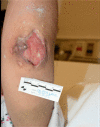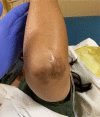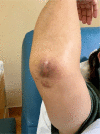MDA-5 dermatomyositis complicated by interstitial lung disease and cutaneous ulcers: successful treatment with corticosteroids, mycophenolate mofetil and intravenous immunoglobulin
- PMID: 32998908
- PMCID: PMC7528359
- DOI: 10.1136/bcr-2020-236431
MDA-5 dermatomyositis complicated by interstitial lung disease and cutaneous ulcers: successful treatment with corticosteroids, mycophenolate mofetil and intravenous immunoglobulin
Abstract
Antimelanoma differentiation-associated gene 5 (MDA-5) dermatomyositis is a subtype of dermatomyositis that is associated with rapidly progressive interstitial lung disease (RP-ILD), as well as with a variety of cutaneous manifestations. Patients with MDA-5 dermatomyositis tend to have a poor prognosis that is often attributed to the high rates of concurrent RP-ILD. Given the severity of disease, early diagnosis and aggressive management is pivotal. We present a case of a 40-year-old woman diagnosed with MDA-5 dermatomyositis who presented with weakness, painful cutaneous ulcerations and interstitial lung disease. She was treated with monthly intravenous Ig (IVIg), weight-based prednisone and mycophenolate mofetil (MMF). After approximately 2 years of treatment, her interstitial lung disease remains stable and she has had significant improvement in weakness and cutaneous ulcerations. Our case provides evidence for early and aggressive treatment of MDA-5 dermatomyositis with a combination of weight-based prednisone, MMF and IVIg.
Keywords: connective tissue disease; drugs: musculoskeletal and joint diseases; interstitial lung disease; musculoskeletal and joint disorders; rheumatology.
© BMJ Publishing Group Limited 2020. No commercial re-use. See rights and permissions. Published by BMJ.
Conflict of interest statement
Competing interests: None declared.
Figures





Similar articles
-
Treatment of myopathy and cutaneous ulcers in anti-MDA5-positive dermatomyositis with triple therapy.BMJ Case Rep. 2024 Mar 21;17(3):e253960. doi: 10.1136/bcr-2022-253960. BMJ Case Rep. 2024. PMID: 38514155
-
[Dermatomyositis and acute interstitial lung disease associated with MDA-5 antibodies: an atypical case].Ann Dermatol Venereol. 2013 Oct;140(10):628-34. doi: 10.1016/j.annder.2013.04.083. Epub 2013 May 27. Ann Dermatol Venereol. 2013. PMID: 24090894 French.
-
Hypomyopathic dermatomyositis associated with interstitial lung disease and good response to mycophenolate mofetil: case-based review.Clin Rheumatol. 2017 Aug;36(8):1919-1926. doi: 10.1007/s10067-017-3671-0. Epub 2017 May 9. Clin Rheumatol. 2017. PMID: 28488124 Review.
-
Mycophenolate mofetil for the patients with interstitial lung diseases in amyopathic dermatomyositis with anti-MDA-5 antibodies.Clin Rheumatol. 2017 Jan;36(1):239-240. doi: 10.1007/s10067-016-3443-2. Epub 2016 Oct 7. Clin Rheumatol. 2017. PMID: 27718019 No abstract available.
-
Diagnosis and treatment of clinically amyopathic dermatomyositis (CADM): a case series and literature review.Clin Rheumatol. 2016 Aug;35(8):2125-2130. doi: 10.1007/s10067-015-2928-8. Epub 2015 Apr 7. Clin Rheumatol. 2016. PMID: 25846833 Review.
Cited by
-
Treatment of myopathy and cutaneous ulcers in anti-MDA5-positive dermatomyositis with triple therapy.BMJ Case Rep. 2024 Mar 21;17(3):e253960. doi: 10.1136/bcr-2022-253960. BMJ Case Rep. 2024. PMID: 38514155
-
Pharmacological Strategies in Dermatomyositis: Current Treatments and Future Directions.Med Sci Monit. 2024 Sep 14;30:e944564. doi: 10.12659/MSM.944564. Med Sci Monit. 2024. PMID: 39275800 Free PMC article. Review.
References
Publication types
MeSH terms
Substances
LinkOut - more resources
Full Text Sources
Medical
